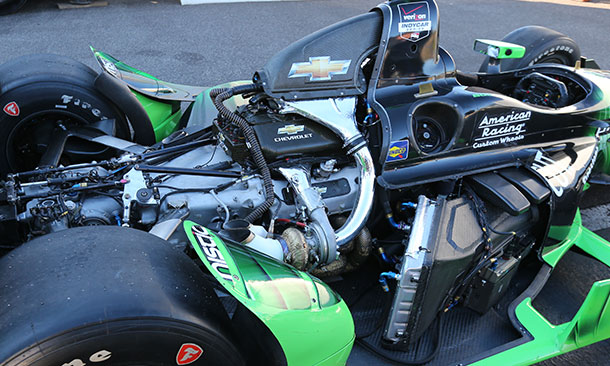Chevrolet tunes engine package for aero kits
MAR 26, 2015
Early in the process of designing the Chevrolet aerodynamic bodywork that will make its competitive debut this week in the Firestone Grand Prix of St. Petersburg, collaboration between the engine group and aerodynamicists at Pratt and Miller – Chevrolet’s motorsports partner -- was instrumental.
Complementing INDYCAR regulations for road/street course and short oval and the speedway aero components were allotments in the 2015 engine homologation rules that allowed manufacturers to alter external piping to the 2.2-liter, twin-turbocharged V-6 engines supplied by Chevrolet and Honda.
Before the first wind tunnel test of prototype components, agreement between the groups on how to achieve performance gains on the diverse set of Verizon IndyCar Series racetracks took precedence, according to Arron Melvin, chief aerodynamicist for Pratt and Miller.
“Initial studies were independent, where aerodynamicists studied what the ideal shape would be without consideration for real-world packaging,” he said. “At the same time, the engine group considers what is best for that and very early we bring those together and start assessing performance sensitivities so we can make a design compromise.
“Fortunately, we were able to arrive at a better package for both engine and aerodynamics so it was a relatively straightforward and coherent trade-off. It starts by not limiting the aerodynamics and assessing what’s possible and then starting to integrate.”
The exhaust header assembly is slimmer and the BorgWarner 7163 engineered-for-racing turbochargers have been repositioned from the 2014 package. The 63-milimeter turbine features a ceramic ball bearing cartridge and titanium aluminide turbine wheel that increases throttle response, which decreases spool-up time.
“We have a shorter tailpipe with a shorter intake system and a tighter position,” Melvin said. “The former is good for engine performance and the latter is good for the aerodynamics as well as weight reduction.”
It also will aid in the efficiency of getting air to feed the turbos and expelling it efficiently.
“Any loss in the intake system, reduction in energy of the air going to the turbos, the turbos must work harder thus generating more heat, which robs power,” Melvin explained. “We work hard to have a clean intake path to make the turbos more efficient, cool and have high horsepower.”
The aero kit distinguishes itself from the previous race car with new front and rear wing elements, new “coked” sidepods with wheel wedges and a new rear wheels guards.
“Along with our technical partners, we recognize that assuming control of a larger part of the performance envelope of the car comes with greater responsibility to our Chevy teams and drivers,” Chevrolet Racing's Verizon IndyCar Series program manager Chris Berube said. “That is why we have worked even closer as a technical team to make sure we have integrated the aerodynamic solution well with our engine and the collective knowledge of our strong team lineup. Our mission remains constant: put all Team Chevy drivers in a position to win at every race. We accomplish this by providing and supporting a powerful, reliable and efficient engine, now with a high bandwidth, fully developed aero kit.”






















